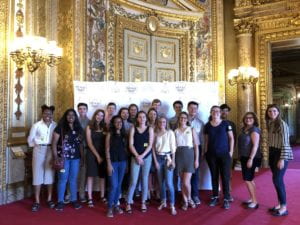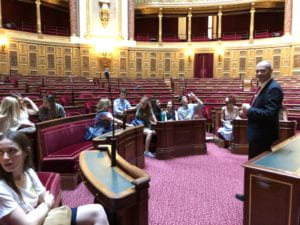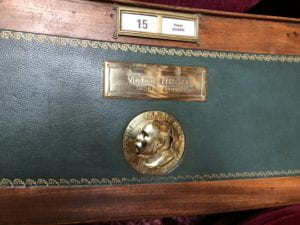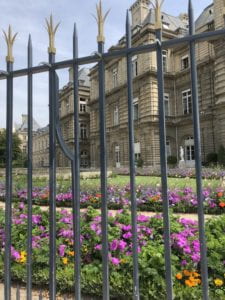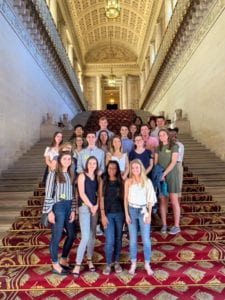Hi! My name is Jack Sheldon and I am a second-year International Affairs and Modern Language (French) student from Atlanta, GA.
Yesterday, myself and 20 other students on the 2019 Georgia Tech European Union and Transatlantic Affairs study abroad had the privilege to visit the Council of the European Union in Brussels, Belgium. The Council of the European Union, also referred to as “the Council of Ministers”, is comprised of Union Member State heads of government along with national ministers who meet regularly in summits and working groups to engage in co-decision with the European Parliament, issue statements, and streamline policies. Yesterday, we were granted access to the Council’s two main buildings in the so-called “European Quarter” of Brussels, the Europa Consilium and the Justus Lipsius.
We began the day with a tour of the Europa building. Recently opened, this building is composed of two sections: the Résidences Palais and the Lantern. Housed in the Lantern are three meeting rooms that can accommodate from 80 to over 300 heads of state and officials. I found the smallest meeting room to be quite interesting, as it had many intentional design features and symbolic elements. First, the entire Lantern is decorated with a mosaic of vibrant colors, allegedly meant to represent colors found in Member State flags. Since lime green and neon pink are not found in any EU flags, I think the colors were meant more-so to project the Union’s motto, “United in diversity.” The building is named “the Lantern” not just for its shape but also to emphasize how the Council and Union are lights of Europe and have a duty to project power and jurisdiction in a positive manner. Logistically speaking, the meeting rooms seat the President of the Council, the High Representative of Foreign Policy and Security, and the Secretariat opposite from the Commission delegation. This shows the dynamic of the Commission acting as policy initiator and the Council working as co-decider with the European Parliament.

Exterior of the Lantern.

Vibrant carpet mosaic on the roof, found throughout the building.

The seats for Council and Parliament leadership.
The chambers are also quite small and elliptical in shape. I found this interesting because, although this allows for leaders and ministers to engage in informal and personal dialogue, it tends to exclude delegations or the press from larger meetings. Each delegation has offices in the Résidences, but it is often helpful to have them on hand (the Danish ambassadorial team has a WhatsApp group message to help with communication issues during summit sessions!). It is hard to imagine that of about four to five thousand people involved in a Council summit, only about 40 sit in the meeting room.
The second part of the Europa building, the Résidences, is the remains of a luxury 1920’s apartment complexes. It was fascinating to see the contrast between old and new; the Union is relatively old but must remain modernized and streamlined to function. In this wing, delegations and other civil servants keep offices.

Neo-renaissance styled hallway of the Résidences office wing.
Following our tour, we moved over to the Justus Lipsius building to be briefed by Mr. Alessandro Vitro, a member of the Council’s Legal Service about the Council as it relates treaty law, security, and defense. Mr. Vitro described three layers of decision-making in the Council: first about 200 expert working groups, then national ambassadors, and finally national ministers and heads of government. Foreign policy and defense are complicated for the Union; I found it quite interesting that the Commission is not able to initiate legislation for these areas, only Member States can. This is often used to rebut the claim that the Union “steals” national sovereignty, as the Member States have not conferred foreign and defense competencies exclusively to the Union.

Students at the Council briefing in a multilateral conference room.
Currently, the Union has 16 defense missions active: 10 civil and 6 military. According to treaty law, these missions cannot operate within the Union. This has posed many logistical and legal problems, especially as it relates to migrant crises in the Mediterranean and Balkans.
During class at Georgia Tech Lorraine, we learned about the Union’s Permanent Structured Cooperation (PESCO). The briefing gave me more context about this body. Spread across three sections in the Treaty for European Union (Maastricht), PESCO has two goals of fulfilling higher defense criteria and making more binding collective security commitments. It looks to increase spending but also make spending more efficient and effective. Currently, the Union is second in the world in military expenditures, however, it only reaps about 10% effectiveness when compared with the United States. I was not aware that PESCO had this utility that is often used to justify its means!
We also learned through students’ Member State presentations that countries like Hungary and Poland have been undergoing democratic backsliding in the past years. Poland, for example, has seen its federal judiciary independence trampled by the reigning Law and Justice (PiS) party. During the briefing, these questions were raised, and it was asked how the Council can use its legal powers to combat and punish these backslides.
According to Article 7.2 of the Treaty on European Union “In the event of a ‘serious and persistent breach’ (i.e. the country does not heed the Council’s guidance) then the Commission or one-third of countries, approved by a two-thirds majority in Parliament, calls the country to answer to the European Council again. The European Council must then decide unanimously to proceed to Article 7.3.” It was then explained that this article has proved ineffective, as invoking it requires unanimity of 28 often divergent Member States. We learned that in these cases the Council tends to hear less from these countries, seeing them as black sheep. This surprised me, because in my opinion times of democratic crisis are not times to throttle dialogues and proceedings.
The third and final part of our visit to the Council was the Visitor’s Centre. In the Centre, we watched films about how the Council, Brussels Police, and others prepare security and logistical arrangements for higher-level officials and European summits. We also got to quiz our knowledge on the Union, and got some fun photos while we were at it!


Students showing their love for the EU!
In summary, the site visit to the Council of the European Union’s main buildings was eye-opening and helped to supplement the class work, discussions, and readings pertaining to the Council, the Union, pooling of sovereignty, and European integration as a whole. It is bittersweet to say that our visits to the Union’s Institutional Triangle are officially over, but I along with my peers have learned so much in the past two weeks. Now to Versailles!
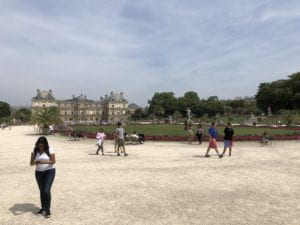
 des Conférences was commissioned during the second Empire and thus holds mainly that stye but it also includes Napoleon’s Throne which was used both by Napoleon and Napoleon III.
des Conférences was commissioned during the second Empire and thus holds mainly that stye but it also includes Napoleon’s Throne which was used both by Napoleon and Napoleon III. 
